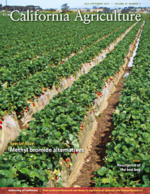
I've discussed soil fumigant issues a few times previously in this blog, but for those unfamiliar with soil fumigation as a pest management practice, here's a brief primer. Fumigants are volatile pesticides that move in the gas phase and penetrate the nooks and crannys and have toxic activity on very wide range of organisms (however, it is a misnomer to say that they "sterilize" soil).
Soil fumigation is a very high cost operation - cost of materials and application equipment, cost of human and environmental safety mitigation, and potential costs to the environment. Because of these limitation, soil fumigation is almost solely a technique used in very high-value specialty crops (think strawberry, nurseries, and to a lesser extent orchards and vineyards).
A very generalized overview of the process of soil fumigation is:
- Fumigant (or a precurser) is applied below the soil surface
- The toxic material moves through the soil in the gas phase (laterally and vertially)
- Pests are subject to an appropriate exposure (concentration x time) to kill them
- The fumigant degrades or is vented from the soil
- The field is planted with the crop.
One of the primary fumigants used in the last 40 years has been a product called methyl bromide. This product has worked pretty well for control of weeds, soil diseases, and plant parasitic nematodes. Unfortuately, it also has negative effects on the ozone layer in the earth's atmosphere and is being phased out per international treaty. This same treaty, the Montreal Protocol, is why we've phased out many solvents, refrigerants, and aerosol propellents over the last 25 yrs.
Over the last 10 years or so, a number of researchers in California and other states have been conducting research to help find alternatives to methyl bromide for specialty crop producers. The research has focused on aspects of the five bullet steps I outlined above, namely:
- testing alternative fumigant products and techniques
- increasing the movement of fumigant throught the soil so that alternatives work better or can be used at lower rates
- Fine-tuning concentration-time calculations and testing methods to increase time of exposure with the hopes of decreasing the neccessary concentration
- Evaluating fumigant fate in soil, trying to minimize emission to the atmosphere, and monitoring off-site movement of the products
- Evaluating crop safety and productivity of field treated with alternative products or treatments.
Recently, a "special issue" of the journal California Agriculture focused on soil fumigants was printed. This issue has the first four of a series of soil fumigation research articles centered on research conducted under the USDA-ARS Pacific-Area Wide Integrated Methyl Bromide Alternatives Program. The next issue of Cal Ag will also focus on the past research and remaining issues surrounding soil fumigation in the state.
If you are interested, I encourage you to go to (or subscribe to) the current issue of California Agriculture Volume 67, Number 3 Special issue: Methyl bromide alternatives for articls by:
- "Managing the almond and stone fruit replant disease complex with less soil fumigant" - Browne et al.
- "TIF film, substrates and nonfumigant soil disinfestation maintain (strawberry) fruit yields" - Fennimore et al.
- "Fumigant emission reductions with TIF warrant regulatory changes" - Ajwa et al.
- "Forest nurseries face critical choices with the loss of methyl bromide fumigation" - Weiland et al.
Besides those research articles, there is also:
- Methyl bromide primer and timeline - Janet White
- Methyl bromide terminology - Janet White
- Specialty crops and methyl bromide alternatives: Taking stock after 7 years - Greg Browne
- Researchers develop alternatives to methyl bromide fumigation - Robin Meadows
- "Preplant 1,3-D treatments test well for perennial crop nurseries, but challenges remain - Hanson et al. (an "e-only" article).
The link again is here: California Agriculture Volume 67, Number 3 Special issue: Methyl bromide alternatives
Take care,
Brad